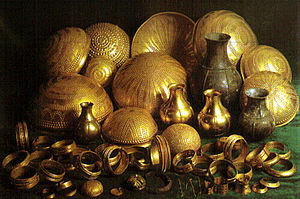Treasure of Villena
This makes it the most important find of prehistoric gold in the Iberian Peninsula and second in Europe, just behind that from the Royal Graves in Mycenae, Greece.
Archaeologists estimate the date of this trove at c. 1300-1000 BCE, within the Late Argar, Post-Argar or Bronze of Levante period.
Its discovery was published in most of the Spanish media and also some abroad, mainly in France, Germany and the United States of America.
It has been exhibited in Madrid, Alicante, Tokyo and Kyoto, and now there are two sets of copies of the whole treasure to be shown in exhibitions while the originals are permanently conserved in an armoured showcase at Villena's Archaeological Museum.
The same type of metalwork is also found in the big Eberswalde Hoard that was discovered in Brandenburg, Germany, in 1913.

